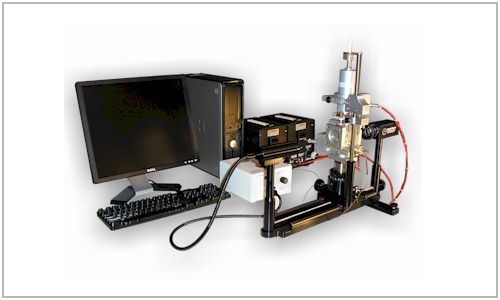|
November 2009 |
||
| Of Phobias and Philicities - Will that be Super or Ultra? | ||
|
In surface science hydrophilicity
(389,000) is characterized by low contact angle. Hydro refers to
water and philicity means an affinity toward. Thus an
hydrophilic (3,510,000) surface exhibits excellent wetting. The
converse is hydrophobicity (1,050,000). An hydrophobic
(5,720,000) surface produces a large water contact angle and
wetting is poor. These terms appear to be the most popular wetting
descriptors as indicated by a Google search; the number of results
appear in brackets - but not all references refer to wetting. Hydro
terms are frequently misused; often a
surface is called hydrophobic when in fact omniphobic or
hygrophobic (discussed below) would be more suitable.
Omniphobia means the fear of everything. Thus omniphobic (13,600), and to a lesser extent xenophobic (1,020,000), have come to describe surfaces that will repel not only water but all types of polar and nonpolar liquids. An omniphobic surface exhibits high contact angles and low contact angle hysteresis for water, oils, and solvents. Researchers at MIT have created nanosurfaces that not only repel water (with a high surface tension) but also low surface tension oils.1 These omniphobic surfaces promise self-cleaning qualities but commercial applications will require less fragility. The terms omniphilic (485) and omniphilicity (3) do not appear in usage...yet. Abraham Marmur has suggested that we use the words hygrophilic (4,590) and hygrophobic (3,780).2 The root hygro comes from Greek and means "liquid". It's not clear if hygro should be used instead of omni since the meaning is nearly the same - or in place of hydro since hydro is often used when referring to not just water but other liquids as well. In general usage, words with the hygro prefix refer more often to plants than contact angle and wetting. So, it's questionable if hygro will ever gain a following in the surface science community. Lyophobicity (2,840) is generally used to describe colloids. A lyophobic (93,100) colloid, for example, is one that repels liquids (solvents) due to the limited interaction between the dispersed phase and the continuous phase. A solid is lyophobic if it repels a solvent. Researchers in Germany are creating lyophilic (86,900) stripes at the nanoscale level on otherwise lyophobic surfaces in order to control the flow of solvents.3 The study of the control of fluids on nanostructured surfaces is a hot new technology called nanofluidics.4 Oleophilicity (6,480) is characterized by a strong affinity for oils. Oleophobic (83,700) surfaces, by contrast, repel oils. The new 3GS iPhone, for example, features a touch screen with an oleophobic polymer film designed to resist fingerprints.5 Lipophilicity (262,000) refers to an affinity for fats, lipids, and nonpolar solvents such as hexane. The terms lipophilic (1,200,000) and hydrophobic are often used interchangeably but are not always synonymous. Silicone, for example, is hydrophobic but not lipophilic. Lipophilicity and oleophilicity, however, are typically synonymous. A surface that is both hydrophilic and lipophilic is said to be amphiphilic (595,000) or amphipathic (381,000). There appear to be an array of additional philicities and phobias which relate to surfaces: amphiphobic (2,660), electrophilic (724,000), cement-philic (29), metal-philic (57), nanovector-phobic (2), solder-philic (101), inkphilic (315), etc. I guess if you are creative and know your roots, you can make up new words as needed. The super and ultra postfixes are added to any of the above descriptors to show extreme conditions. Generally any surface with a water contact angle over 150° is described as superhydrophobic (129,000). This condition is also called the Lotus effect. If the water contact angle exceeds 160° then ultrahydrophobic (21,100) is used to describe the surface. It seems a lot of people take liberties with the use of these terms. In literature, ultrahydrophobic is often used to describe contact angles which are not even or barely superhydrophobic. Superhydrophilicity (19,400) is used to describe complete or nearly complete wetting when the contact angle is at or close to 0°. Ultrahydrophilic (1,560) does not appear to be used much and when it does appear, it's used interchangeably with superhydrophilic. Lest we forget: logophobia (196,000), the fear of words. 1
http://tinyurl.com/yljxz3m |
||
| Product of the Month | ||
|
The featured product this month is our Model 500 Advanced Goniometer / Tensiometer. The Model 500 represents our most top-of-the-line product capable of measuring static and dynamic contact angle, surface energy, surface tension, and with the optional Oscillator, surface dilatational elasticity. Model 500 ships with our DROPimage Advanced software which is the most capable of the (3) editions of DROPimage that we offer. The methods-based experiment tools and editors allow for powerful experiment design with features for constant volume, trigger, delay, and fully software control of the optional Automated Dispensing System and Automated Tilting Base.
The power of Model 500 becomes evident when you discover the endless configurations that are possible. Model 500 is the only product in our line-up which supports every available modular accessory. You can add an Environmental or Advanced Chamber to control the temperature or humidity or both. The Elevated Temperature Syringe is an excellent option for working with solders and high-melt polymers. Rotating Wafer Supports are available in various sizes for working with silicone and other wafers. A Rotating Vacuum Chuck or Film Clamps are useful for working with sensitive thin films. Add a Tilting Base for measuring advancing and receding contact angle and roll-off angle. The most popular option is the software-controlled Automated Dispensing System for increased drop volume precision and for doing automated dynamic studies. An Environmental Fixture can be added for any type of liquid-liquid study including captive bubble, inverted pendant drops, inverted sessile drops and conventional pendant and sessile drops and bubbles with a liquid or gas external phase. If you would like a quotation or would like to know more about the Model 500 Advanced Goniometer / Tensiometer, please contact us or call 973-448-0305. |
||
|
||



